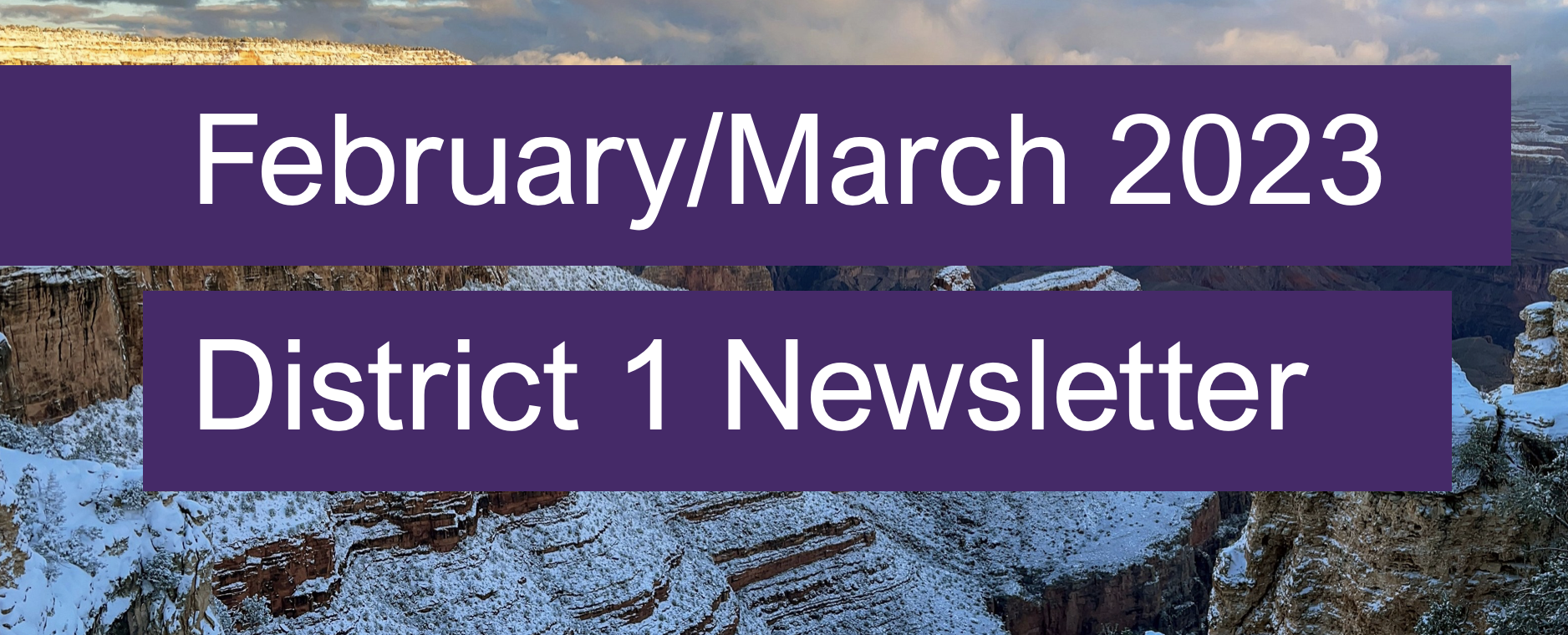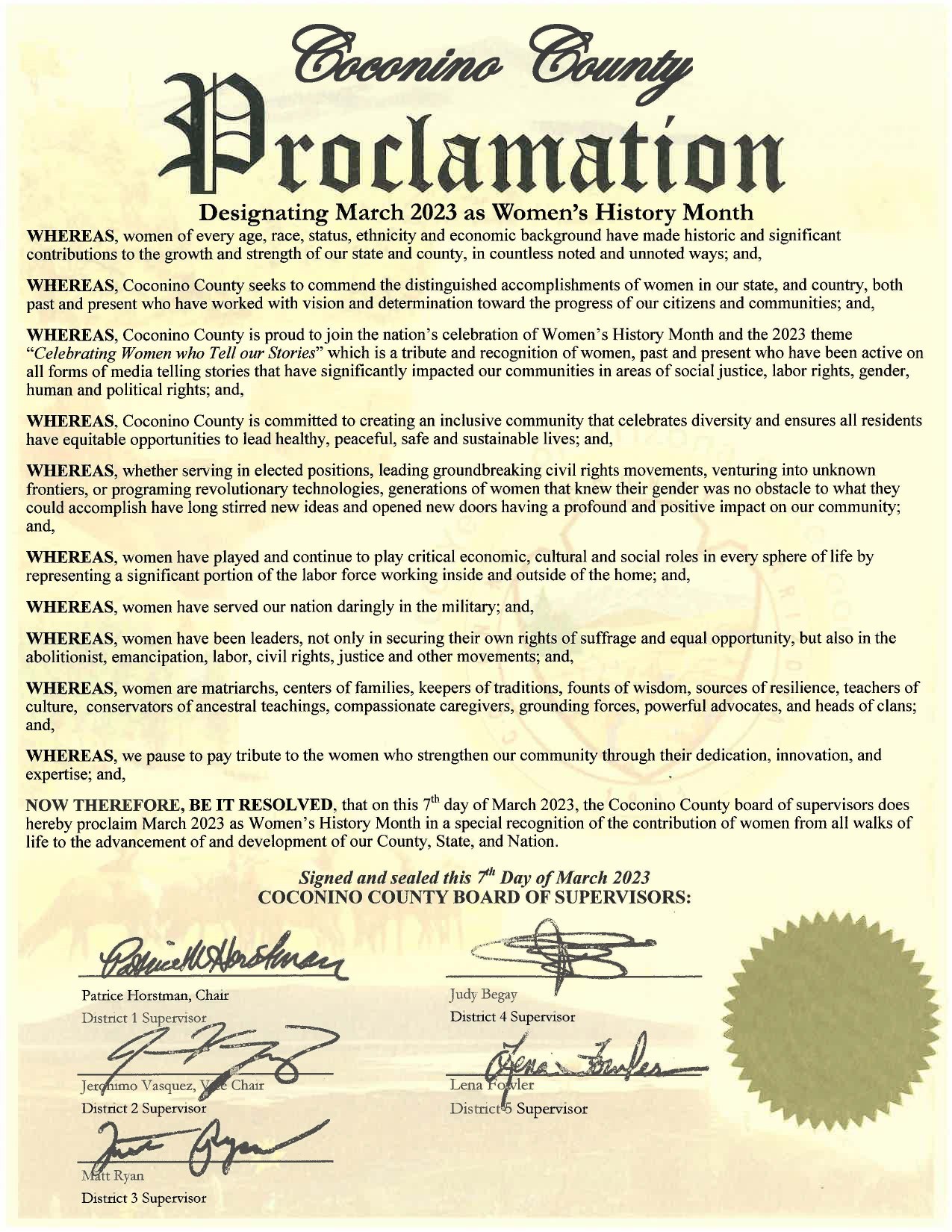In This Issue
- Hello from Supervisor Horstman
- Short Term Rentals
- Hearing on Coconino County Fair Fees
- BOS Adopts New Fort Tuthill Management Plan
- Upper Rio de Flag Watershed Forest Restoration
- County Receives $10.9 Million State Funding for Flood Mitigation
- County Comprehensive Plan and Flagstaff Regional Plan Explained
- Community Meeting on Proposed Forest Restriction Plans and Emergency Preparedness
- NACo Legislative Conference
- Fort Valley Gets Its Sign!
- Fort Valley Community Meeting on Rain and Snow Melt
- Valle It Is!
- County Parks and Recreation Receives Arizona Forward Environmental Excellence Award
- Congratulations to Jim Driscoll, Western States Sheriff of the Year!
- Community Events
Hello From Supervisor Horstman
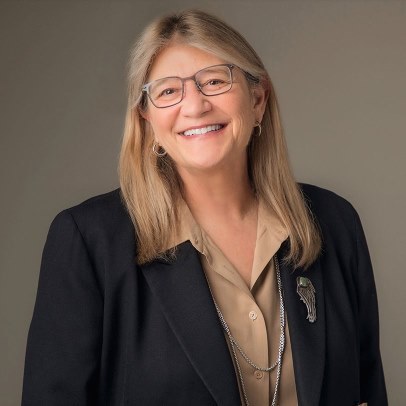
Patrice Horstman
Hello District 1 Residents
This has been a winter for the record books. After a snow filled February, the snow continues to fall, rendering March another snow record breaker. I’m writing this on what the calendar says is the first day of spring. Yet, the National Weather Service has announced another heavy winter storm is on its way. So don’t stash your snow shovels just yet.
Coconino County continues to fast track its flood mitigation efforts in order to complete projects before our monsoon season. Construction will be weather dependent. However, Coconino County and its partners are positioned to begin work as soon as possible. The County also got good news this month when Arizona committed $10.9 million towards the County’s flood mitigation effort. A strong Federal, County and State partnership has been essential to delivery long term flood mitigation to our devastated communities.
March is also Women In History month and the Board of Supervisors joined the nation in recognizing the accomplishments of women. The 2023 theme is “celebrating women who tell our stories”. Many of us can reflect on the earlier years of the women’s rights movement and the fight for equal opportunity for women in all parts of our society and economy. Much has been gained since the 70s and 80’s, but there is still much more to accomplish for full equity. We all gain from diversity and inclusion. By striving together, we create the community where we want to live, and where we want to raise our children.
Onward together, Patrice
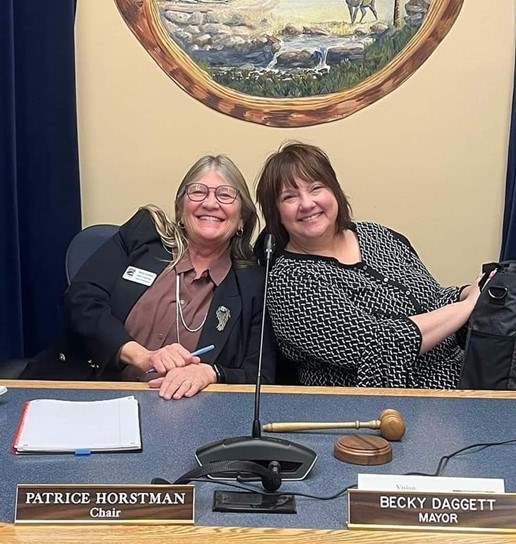
Celebrating International Women’s Day, BOS Chair Patrice Horstman an…
Short Term Rentals

On February 28, the Board of Supervisors held a public hearing on the County’s proposed short term rental ordinance (STR). More than 50 County residents sent in written comments on the ordinance and over 20 people spoke during the February 28th public hearing. Most of the commenters recognized the limitations of the current state short term rentals statute and acknowledged that the County ordinance could only provide limited overview and regulation by the County. In particular, the public noted, with favor, that the state regulations allowed municipalities to register short term rentals, required that neighbors be notified that a home was being utilized as a short-term rental, required the listing of a contact person with an address and phone number, imposed an escalating fine for violation, and allowed municipalities to set up an administrative review process for determining violations.
At the hearing, the public and BOS members expressed ongoing concerns regarding the state STR statutory language and the laws failure to clearly defined what is prohibited activities on short term rentals, and failed to set forth what activities could be regulated by municipalities. After the hearing, recommendations were made to modify the County’s draft ordinance and to more specifically set forth what activities the County was regulating, add a definition section, and set forth a more expedited process to determine STR violations.
This was brought back to the board during the board meeting of March 21. After further discussion, the Board expressed a desire to send the proposed ordinance back to County staff and legal for substantial revisions of the ordinance consistent with the recommendations raised during the public hearing. In the motion, the Board voted that the new ordinance would receive further public review and a new public hearing.
As Supervisor Horstman noted, it is more important that we get it done right rather than to get it done quickly.
Hearing on Coconino County Fair Fees
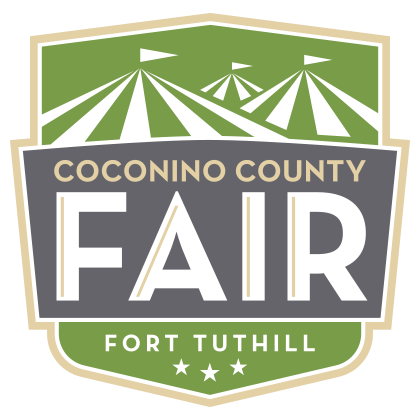
In keeping with the needs of the Coconino County Fairgrounds, in February the BOS heard a recommendation for proposed fee changes for admission to the Coconino County Fair for 2023. The recommendation provides free public parking at the fairgrounds instead imposing the current parking fee. Admission, however, for adults, seniors, and active-duty military/veterans would go up slightly. Adult prices would go from $8 to $10, senior prices for age 65 and up would go from $5 to $6 and military/veteran prices would go from $7 to $8 dollars. Youth admission tickets would remain the same but would increase by $1 in 2024. Children under the age of five would continue to be admitted free of charge.
County fair admission prices have not increased—for over a decade —since 2008. The modest fee increase reflects the increase in costs for staff and maintenance and would still provide affordable family fun with music and free entertainment.
The fee increase proposal is scheduled for a public hearing on Tuesday, April 11 at 6:00 PM during the BOS board meeting. The public can be heard and participate in the discussion via zoom webinar technology at: https://us06web.zoom.us/j/85064783174
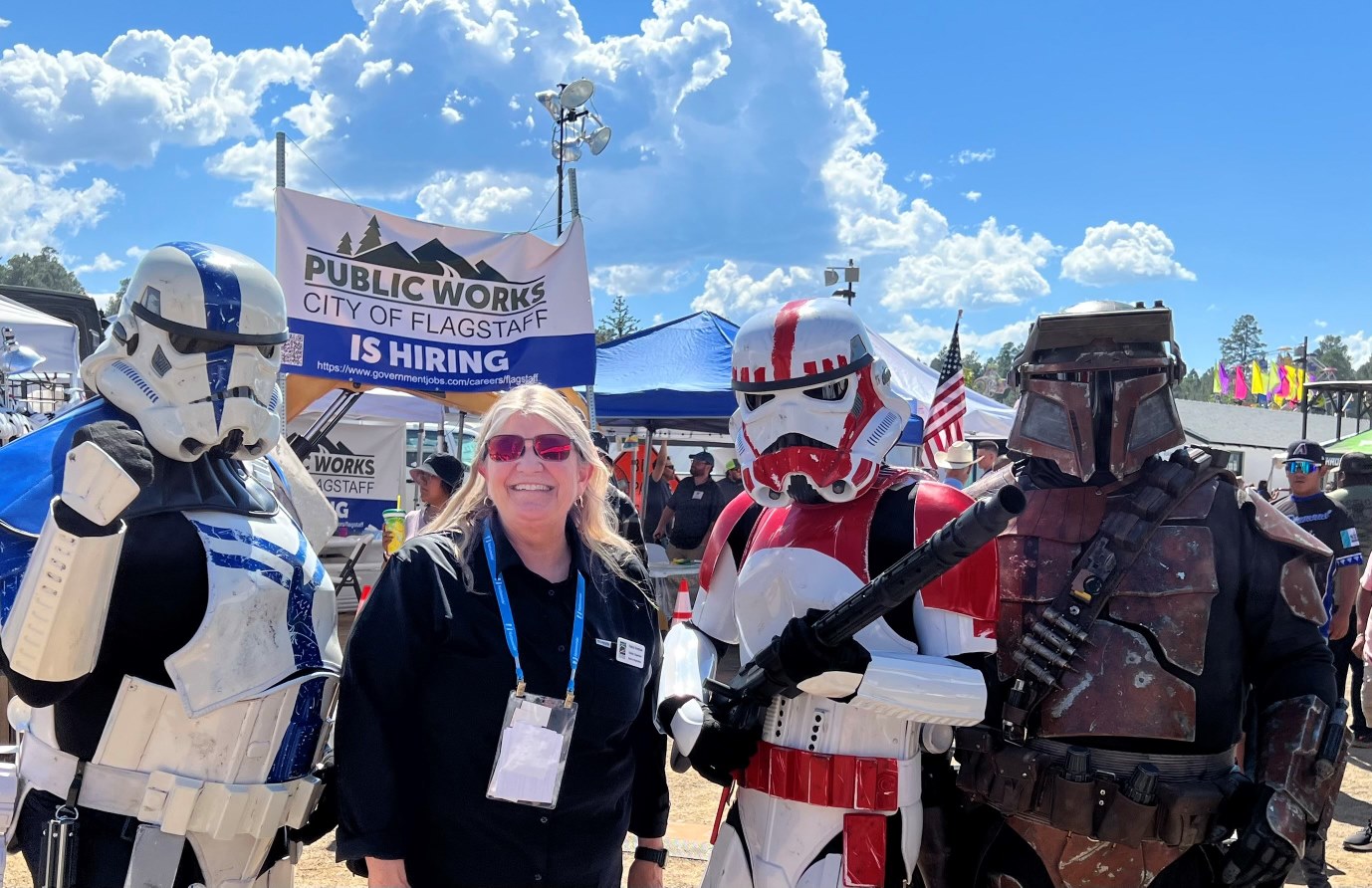
Chair Patrice Horstman and the Star Wars Gang
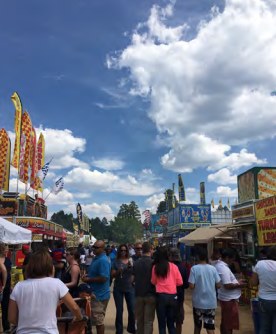
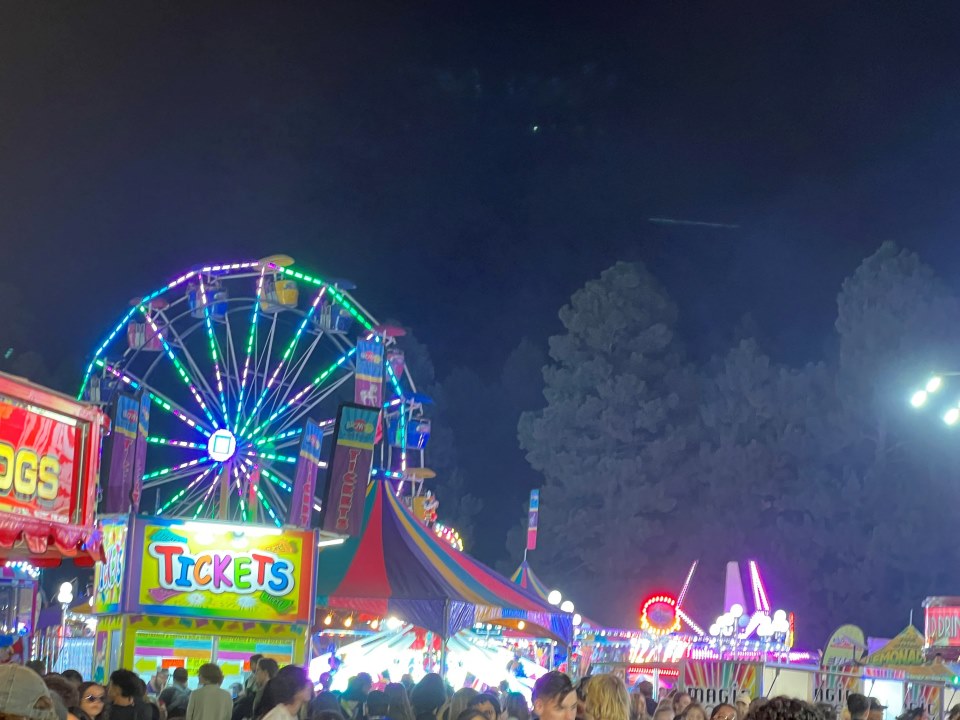
BOS Adopts New Fort Tuthill
Management Plan
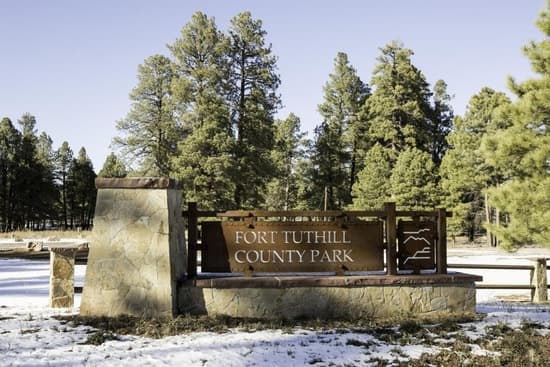
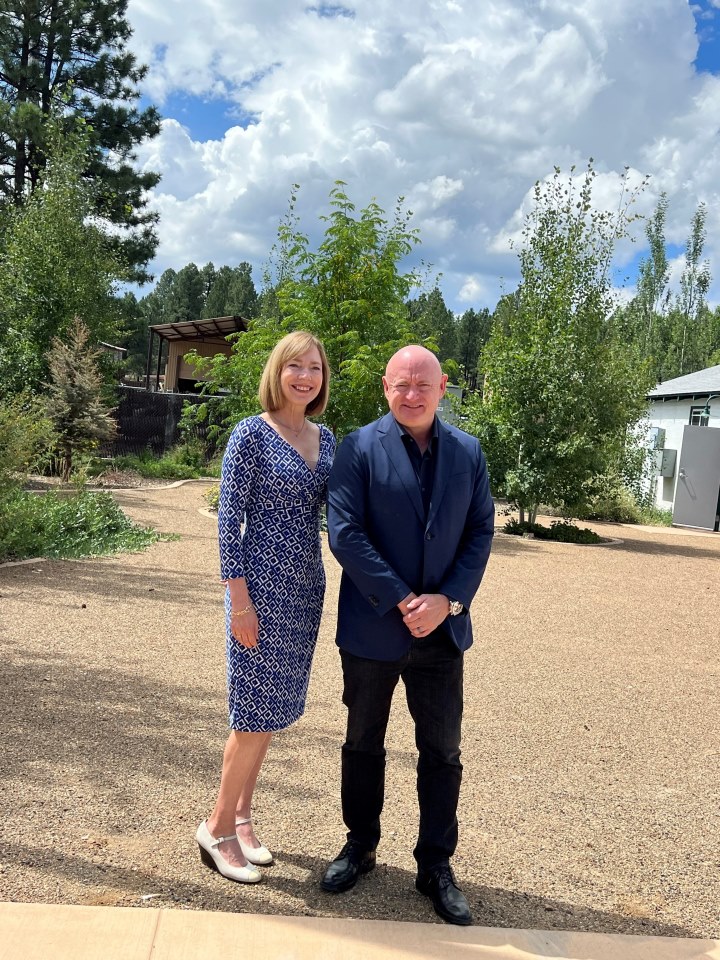
Cynthia Nemeth Director Parks and…
The crown jewel of Coconino County parks system is the Fort Tuthill County Park. Located 3 miles from downtown Flagstaff, Fort Tuthill consisting of 621 acres and is the largest of the County’s parks. Fort Tuthill offers open space under towering ponderosa pines for recreation activities and wildlife viewing. Back in the day, the park hosted a rodeo, horse-racing, and the county fair. Over the years, our beloved county fairgrounds remain, and the space has also evolved into campgrounds, a snow play area, archery, hiking and biking trails, equestrian arenas, and a premier outdoor music venue.
From its roots as a field training site for the national guard during the 1920s and into the ‘40’s, the park has grown in scope and size but remains committed to a balance of developed areas and open space preserved for recreation, trails, wildlife, and quiet solitude. An addition 220 acres to the northwest portion of the park shall remain undeveloped, continuing this commitment.
Fort Tuthill County Park has seen many changes and through it all, the County has been guided by thoughtful management plans. These management plans, although changing over time, remains true to its core commitment of preserving the park’s history, culture, and natural environment, while serving our communities outdoor recreation needs.
Last month, Coconino County Parks and Recreation and the Board of Supervisors finalized a new management plan to guide the park through the expected changes that will be occurring with the advent of Northern Arizona Healthcare’s (NAH) plan to relocate the Flagstaff hospital and build a wellness a community including housing, hotel, commercial enterprises, and other developments, immediately north of Fort Tuthill. This substantial change in the land adjacent to Fort Tuthill will bring more people to the park and requires a thoughtful look into the future to ensure that the County is managing and protecting this wonderful and unique space.
Visitors and residents alike are encouraged to visit the park and enjoy its many recreational activities and offerings. Let’s work together to keep the park beautiful and preserve it for future generations.
A link to the comprehensive management plan can be found at: Parks & Recreation | Coconino (az.gov)
Fort Tuthill interior walkways
Fort Tuthill picnic ramadas
Upper Rio de Flag Watershed Forest
Restoration
Flagstaff is a mountain town, surrounded by the largest Ponderosa pine forest in the world. Mix in a mega drought and we must face the realities of a potential for disaster. In recognition of this, the Coconino County Board of Supervisors declared the risk of wildfire and post wildfire flooding as the number one health and safety risk to the residence of Coconino County. With this declaration, the BOS and County launched a Forest Restoration Initiative that identified and prioritized high risk areas for forest restoration. This included the Board, acting as the County Flood Control District (FCD), raising the FCD tax in order to raise $30 million over 5 years for forest restoration efforts. This is a massive undertaking and requires partnerships with the federal government, including the Forest Service, the City of Flagstaff, and private partners.
The west side of the San Francisco Peaks that make up the Upper Rio de Flag Watershed remains high priority for forest restoration. The west side of the Peaks includes just under 22,000 forested acres. Forest treatment on the Peaks has been prioritized in recognition that the Upper Rio de Flag Watershed drains into the communities of greater west Flagstaff including Fort Valley, Cheshire, Coconino Estates, parts of Old Town, Downtown, into NAU and the Southside. Recently, the FCD commissioned modeling of potential wildfire and post wildfire flooding in the Upper Rio de Flag Watershed. The preliminary results of the modeling make it clear that the impacts of a fire in the Upper Rio de Flag Watershed would be devastating for the west side of greater Flagstaff, with an economic impact that would likely top $1 billion.
The Forest Service in 2022, made a $54 million annual commitment for five years through the Four Forest Initiative (4FRI) projects, which includes the Coconino National Forest and projects in the San Francisco Peaks. Both the Infrastructure Bill and Inflation Reduction Act also brought money to the Forest Service for forest restoration efforts. The County, together with the Forest Service and Flagstaff are working to commence restoration efforts, which include expensive steep slope thinning on the peaks. As noted by FCD Director Lucinda Andreani, “in order to reduce the overall risk of fire and reduce the ultimate risk of post-wildfire flooding, and the impact on our economy, the entire area of the Upper Rio de Flag Watershed will need to be treated. This is going to take a partnership with the FCD, City of Flagstaff, and Forest Service, with all parties coming forward with funding.”
Jay Smith, Forest Restoration Director and Supervisor…
Regeneration in the foothills of San Francisco Peaks
County Receives $10.9 Million State
Funding for Flood Mitigation
The Board of Supervisors, acting as the Flood Control District (FCD), approved the acceptance of two federal grants totally $90 million. This approval enabled the FCD to immediately proceed with the long-term flood mitigation projects in the Schultz-Pipeline flood area.
The acceptance of the grants requires a 20% County match for the federal Emergency Watershed Protection (EWP) Act portion of the funding. The County, therefore, must contribute approximately $11 million towards the flood mitigation projects funded by these events. This funding is on top of the millions spent by the County in unreimbursed fire suppression costs and in mitigation expenses excluded by the federal grants. To offset this cost to the County, and to avoid the County having to cut services or programs, the FCD applied to the Arizona Department of Forest and Fire Management (DFFM) and requested state funding for this federal match requirement.
The County is pleased to announce that the DFFM awarded $10.9 million to Coconino County to assist in covering this federal match. Arizona’s new DFFM Director Thomas Torres stated, “this allocation of state money to communities that are severely impacted by wildfires, reflects a continued commitment by state government to local governments, dealing with the devastating results of severe wildfires.” Director Torres is well aware of the importance of the federal-state-county partnership as he has served 33 years with the Forest Service with expertise in wildfire management and forest restoration.
The DFFM, under Director Torres’s leadership, also awarded $16.1 million to the City of Flagstaff to help repair in Flagstaff’s inner basin water pipeline along the Waterline and Schultz Pass roads. The inner basin water pipeline, which provides a major source of water to greater Flagstaff, was severely damaged in the Pipeline fire and post wildfire flooding.
Supervisor Horstman extends a heartfelt thank you to the state of Arizona and DFFM Director Tom Torres for its assistance to Flagstaff and our northern Arizona communities.
County Comprehensive Plan and
Flagstaff Regional Plan Explained
Both Coconino County and the City of Flagstaff have commenced their respective long range planning processes. Coconino County is commencing its ten-year Comprehensive Plan and Flagstaff has started its planning for the Flagstaff Regional Plan. These are for two important and separate planning processes and the County and City will each create separate planning documents that will shape our future. In the coming weeks and months, you will see both the County and the City holding regular community meetings and urging your involvement.
Supervisor, Horstman encourages you to join the City and County during these meetings and be a part of the visioning for our future. The Flagstaff region is home to the majority of the County’s population. The Flagstaff regional plan provides more detail for the Greater Flagstaff (metropolitan) area.
As is more clearly explained below, these two documents work together to provide a vision and direction for future development within the City and the County.
1. What is the Coconino County Comprehensive Plan and why is it important to Coconino County Residents?
Coconino County’s Comprehensive Plan is the County’s long-range policy document. It provides a twenty-year vision and guide for future physical, economic, and social development for the entire county, and contains maps, goals, policies, and implementation actions that guide decisions about the County’s future, in particular land use decisions. State law requires that the Comprehensive Plan address a range of topics, and that it be updated every 10 years. The current plan was adopted in 2015, and the process to update the Comprehensive Plan, Envision 2045, is beginning now, in 2023.
The planning area for the Comprehensive Plan includes the entirety of the unincorporated area of the County, including the nine unincorporated communities with area plan areas, and other unincorporated communities without area plans. While there are six incorporated communities within Coconino County, the County does not plan for those areas, with the exception of the current coordinated effort between the City of Flagstaff and the County to update the Flagstaff Regional Plan.
2. What in the Flagstaff Regional Plan and why is it important to Coconino County Residents?
Like the County’s Comprehensive Plan, the Flagstaff Regional Plan is a policy guide that serves as the general plan for the City of Flagstaff and as an amendment to the Coconino County Comprehensive Plan. As mandated by state law, the Regional Plan covers a range of topics, with a focus on land use, and includes information about current conditions, a future land use map, and goals and policies that are developed to realize a vision for the future. The current plan adopted in 2014 is being updated now to stay in alignment with the state mandated 10-year update requirement.
The Flagstaff Regional Plan is unique in Arizona. The planning area encompasses the entire boundary of the transportation (metropolitan) planning area including the City of Flagstaff and the unincorporated county communities of Bellemont, Fort Valley, Mountainaire, Kachina Village, and Doney Park, Timberline, Fernwood. Because the planning area includes land under both city and county jurisdiction, the Flagstaff Regional Plan is jointly developed by the City of Flagstaff and Coconino County, and is used by both the city and county to guide land use decisions. The Regional Plan is important to County residents and property owners within the Flagstaff region because the goals, policies, and the future land use map are applied to properties in the unincorporated portions of the region.
3. How will overlapping planning efforts to update the Flagstaff Regional and the County’s Comprehensive Plan be Coordinated?
Both planning processes are very important for County residents because each of the documents are used by decision makers to help guide land use decisions. The Comprehensive Plan’s goals and policies will address the county as a whole and affects properties under county jurisdiction both within and outside of the Flagstaff Regional Plan boundary, while the Regional Plan goals and policies affect only properties within the Regional Plan boundary. Because the timing of the two planning efforts is overlapping, information, data, visioning, and goals and policies that are developed for the Regional Plan will help inform the Comprehensive Plan update. At the same time, the Comprehensive Plan’s update process and the information, data, visioning, and goals and policies will extend across the entire county, not just the Flagstaff region.
Community Meeting on Proposed
Forest Restriction Plans and
Emergency Preparedness
Last summer Coconino County experienced two devastating wildfires that started on the Coconino National Forest. Our communities are, therefore, very aware of the importance of implementing appropriate and meaningful fire restrictions to help reduce wildfire risks. On March 15, community members braved a cold and rainy night to hear from Flagstaff District Ranger Matt McGrath, Supervisor Horstman and County staff on the Forest Service’s proposed fire restrictions.
Those in attendance expressed general approval for the new proposed fire restriction changes that limit camping and campfires in strategic and sensitive areas within the Flagstaff Ranger District. This proposal would increase the boundaries for the existing year- round camping and campfire bans on forest property located adjacent to the City of Flagstaff and the greater Flagstaff communities of Munds Park and Kachina Village. Also, the Forest Service proposal strengthens stage 2 fire restrictions by prohibiting motor vehicle use on the forest during stage two fire restrictions around the San Francisco Peaks, Walnut Canyon, and Pumphouse Wash. Snowbowl road and FS roads FR516/Snowbowl Road, FR418, and highway-adjacent trailheads remain open would remain open during stage 2 fire restrictions and hiking, mountain biking, and equestrian use during stage two fire restrictions would continue to be allowed.
The maps below set forth the areas subject to these proposed fire restrictions.
Jay Smith, Forest Restoration Director, provided an update on the County’s Forest restoration priorities for the Upper Rio Watershed. County Assistant Emergency Manager Director Tim Carter provide an overview of the county’s emergency management notification system and reminded the public of the importance of preparing for emergencies through creating a family emergency plan and a “go bag”. Also, of the importance of being aware of the “READY, SET, GO!” notifications used for emergencies. Mr. Carter urged all to sign up for emergency notifications at: Arizona Emergency Information Network | Arizona Emergency information Network (az.gov)
Monsoon season will soon be upon us. So please familiarize yourself with the County’s emergency management plan and recommendations.
Patrice Horstman, Supervisor District 1
Matt Mcgrath, District Ranger, Coconin…
Jay Smith, Forest Restoration Director
Tim Carter, Assistant Director Emergenc…
NACo Legislative Conference
From the left Keith Brekhus, Government Relation Policy…
Joan Pliego, County Communications Director, Supervisor Judy Begay,…
Coconino County Supervisors and staff traveled to Washington DC in February for the National Association of Counties (NACo) Legislative Conference. This annual conference brought together County Supervisors and Commissioners from around the country to share information and advocate on behalf of County government.
Supervisor Horstman sits on the Western Interstate Conference (WIR) and Public Lands Steering Committee, and the county presented three resolutions to the NACo WIR and Public Lands committee that were ultimately accepted for approval by the full NACo membership. Two resolutions addressed the needs for a robust federal response and additional federal financial assistance for counties to allow counties to better address the wildfire and post-wildfire flooding threat in the West. The last resolution dealt with the need to adopt a national drought policy, which included addressing the challenges presented by the western United States, and particularly, the ongoing drought on the Colorado River Basin.
NACo recognized Coconino County and Apache County, by awarding them the NACo Building Resilient Economies in Coal Communities (BRECC) Action Challenge grant. This grant gives these two coal counties greater opportunities to collaborate on solutions and economic development for communities impacted by coal plant closures.
Coconino County continues to be very active in the National Association of Counties, and very proactive in working with our federal delegation and the congress. This advocacy is essential so the BOS can continue to deliver on behalf of our residents.
Fort Valley Gets Its Sign!
Fort Valley, a beautiful and historic community, has long attempted to get a sign installed along state route 180 to announce to travelers that they are entering Fort Valley. After months of frustration trying to obtain ADOT’s approval for a sign placement along 180, the County reached out and obtained the consent of private property owner, the Arizona Snowbowl, for the placement of the Fort Valley sign on its property along 180. The Fort Valley community provided design input and Supervisor Horstman is happy to report that District 1 and the County is proceeding with the production and installation of the sign. The new Fort Valley sign will soon be greeting travelers along 180.
Fort Valley Community Meeting on
Rain and Snow Melt
Given the historic snowfall, and the expected spring melting and ponding, the County Flood Control District (FCD), together with Supervisor Horstman, held a virtual meeting on Sunday, March 19 for the Fort Valley/ Baderville area. County Staff discussed mitigation measures for potential ponding and for septic systems that may experience saturated drain fields that could interfere with septic systems properly draining. Arizona Department of Health Services (ADHS) provided information on how to protect wells and on well testing information. For more complete information, please visit the County’s FCD website set up specifically for the Fort Valley area to address spring run-off concerns: Snow Melt Ponding | Coconino (az.gov)
The FCD has also placed sandbags along Bader Road and at some of the Fort Valley neighborhood intersections for those homeowners in vulnerable ponding areas to assist in shoring up homes. For sandbag information and instructions on the proper placement of sandbags, please check out the information found on the County FCD website listed above.
Many long time Fort Valley residence are familiar with the concerns associated with spring runoffs and can provide firsthand advice to newer residents. If you missed the meeting, you can listen to the meeting on YouTube at: (157) Fort Valley Ponding Community Meeting: March 19 2023 – YouTube
Representatives of the National Weather Service provided a near term and three month forecast. The forecast calls for continued precipitation through March and into April and with a growing drying trend for the remainder of the spring. The weather forecast and weather maps can also be found on the FCD website listed above.
Unfortunately, the virtual meeting did not have a Q and A set up. However, the public is invited to provide questions and comments through email at: SnowMeltPonding@coconino.az.gov
Every question submitted will receive a response. Feel free to also contact Supervisor Horstman’s office directly. Supervisor Horstman will be scheduling an in-person community meeting later this spring for further information and discussion.
Valle It Is!
Supervisor Horstman received a decision by the US Board on Geographic Historic Names rejecting the town of Valle’s request to be renamed Grand Canyon Junction. Supervisor Horstman had previously provided support for the renaming of Valle to Grand Canyon Junction. The Arizona State Board on Geographic and Historic Names did not agree with the name change citing no compelling reason to change the name. The US Board on Geographic Names, therefore, rejected the proposal and Valle shall remain Valle.
County Parks and Recreation
Receives Arizona Forward
Environmental Excellence Award
Congratulations to Coconino County Parks and Recreation for being selected as a finalist for the Arizona Forward Environmental Excellence Award for its sustainability and conservation work at the Liz Archuleta County Park formerly Sawmill Park. If you haven’t visited the park recently, please make it a priority. Willow Bend Environmental Education Center also calls the park home. So, include a stop at Willow Bend as part of a fun family filled day. Great work Parks and Rec!
Park Mural
Congratulations to Jim Driscoll,
Western States Sheriff of the Year!
Congratulations to Coconino County Sheriff Jim Driscoll, for being awarded Sheriff of the Year by the Western States Sheriff’s Association of Counties
for 2022-23. Sheriff Driscoll has served Coconino County well for more than 40 years. Thank you, Sheriff!
Sheriff Jim Driscoll
WSSA Sheriff Driscoll Sheriff of the Year 2023
Community Events And Resources
Happy St. Patrick’s Day
Vaccinations available https://bit.ly/36hOFUS. https:/…
For more information please visit: coconino.az.gov/socialservices…
Contact Us

